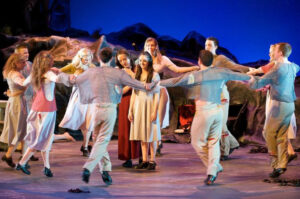In writing my selection of a ‘Book of the Year’ before Christmastide descended on us all, I ended up writing about what was for me was a special book of importance, but was not the one I first intended to celebrate.
But because of that change of plan, always inherent in writing for a weekly paper, I would still like to say a few words here at the opening of a New and hopefully peaceful year in 2024, I would not like to lose the chance to remind readers of what is another very remarkable book indeed, one that that goes to the very heart of Irish tradition and culture as celebrated and enjoyed in rural Kerry and as expressed by the people themselves.
So the most important book I read during the year was Fr Pat Ahern’s Forging the Dance: Eachtraí mo Shaoil – Exploring the Concept of Folk Theatre and the Birth of Siamsa Tíre (O’Riain Publishing, €20.00). It is an account of his life both as a priest and as the co-founder and developer of Siamsa Tíre.
Pat’s life-long ministry at St John’s parish in Tralee (1957-present) was interrupted on two occasions. He was seconded to the Catholic Communications Centre in Dublin (1968-73) and served later as a curate in Knocknagoshel on the Kerry-Limerick border (1985-1990).
Legend
Knocknagoshel, it will be recalled, was a place remembered in modern Irish legend on account of a large banner carried by local nationalists to a meeting in Newcastle West in 1891, which was addressed by Parnell himself.
The banner was inscribed in large letters: “Arise Knocknagoshel, and take your place among the nations of the earth!”
Urban sophisticates then and later were inclined to smile at the innocence of the Kerrymen; but we should bear in mind those wise words from Patrick Kavanagh about his native place at the time of the Munich Crisis in 1938. Was a small Irish townland really important in the greater scheme of things:
I inclined
To lose my faith in Ballyrush and Gortin
Till Homer’s ghost came whispering to my mind.
He said: I made the Iliad from such
A local row. Gods make their own importance.
It is a reminder to us all that what we call ‘universal history’ is always at heart local history.
Pari passu with his priestly ministry at St John’s, Pat pursued his second vocation, promoting Irish song, dance and music and Irish traditional folk culture. While recruiting for his choirs, he was ever on the look-out for talented traditional musicians and dancers.
With 20 or so of these he formed a permanent group of performers and with them presented concerts and began a series of experiments in the concept of ‘folk theatre’. When they performed on RTÉ they were named ‘Siamsóirí na Riochta’ (The Entertainers of the Kingdom).

Staple
In time the content of these programmes became the staple element in the folk entertainment developed and fostered by Siamsa Tíre, the National Folk Theatre of Ireland, founded in 1974 and in which Pat served as artistic director until he retired in 1997.
The resurgence of interest in Irish music and dance has been remarkable in recent years. This book clearly records the unique and seminal role Siamsa Tíre and Fr Pat Ahern had in that resurgence of interest: he too made his own importance from local things.
This book is also important for another reason. The most modest of men, Pat’s narrative tends to be all about others never about himself. Thus the contribution of the others who with Pat have given us the national treasure that is Siamsa Tíre is duly acknowledged.


 The Siamsa Tíre theatre in Tralee.
The Siamsa Tíre theatre in Tralee. 